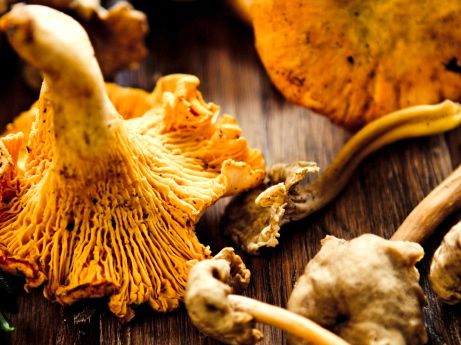
feature-image, l
(article, Christina Eng)
[%pageBreakSettings nobreak=true] In Mycophilia: Revelations from the Weird World of Mushrooms, journalist and noted food writer Eugenia Bone documents not only the science, lore, and tasty appeal of mushrooms, but the distinct subculture of fungi aficionados. Mushroom hunting, Bone reminds us, is more than simply traipsing through the woods after weeks of wet weather, eyes to the ground. It requires a decent amount of patience, fearlessness, skill, and “knowledge both of the organism and of its habits and habitats.” Some people, writes Bone, gather mushrooms for the thrill as well as the taste. They join mycological societies that offer “lectures on fungal biology, slideshows of mushroom photography . . . \[and\] small guided walks.” They take part in regional forays and festivals. Like Bone, these devotees look forward to spring, when morels — “probably the most fetishized of all wild edible mushrooms” — can be found in abundance. Good ones mean delicious meals afterward. But bad ones, of course, can send you to the hospital. One cap of an Amanita phalloides, for instance — a mushroom better known colloquially as "death cap" — “will make you very sick, even do you in, especially if you exhibit symptoms within six hours of eating.” Telltale signs of mushroom poisoning include gastrointestinal pain, vomiting, and diarrhea. Some mushroom seekers forage not for the flavor but for the money. Commercial pickers who hunt for chanterelles, truffles, and matsutakes in the Pacific Northwest, for example, are part of a thriving industry that generates hundreds of millions of dollars a year. They sell the mushrooms they find in the wild to restaurants or distributors, following a trail from British Columbia in the summer south to Washington and Oregon in the fall and northern California in the winter. [%image feature-image float=right width=400 caption="Prize of the mushroom hunter."]Made up primarily of Laotian, Cambodian, Hmong, or Mien immigrants, Latino migrant workers, and “white off-the-grid types,” the workforce can get competitive. Stories abound of groups “staking out and defending territory in national forests with automatic weapons,” the author tells us, “robbing each other of their mushrooms and robbing the mushroom buyers of their cash.” This is not a peaceful walk in the woods. Bone — whose food books include At Mesa’s Edge: Cooking and Ranching in Colorado’s North Fork Valley and Well-Preserved: Recipes and Techniques for Putting Up Small Batches of Seasonal Foods (nominated in 2009 for a James Beard Award) — also touches on other aspects of mycology in the United States today. Talk of fungi biology and molecular make-ups, of spore dispersal (the way in which spores ensure their survival), ecosystems, and parasites get fairly heady. They prove a bit much for non-academics to fully comprehend. Likewise, the chapters on psychedelic mushrooms — “the black sheep of the mycological world” — and mycotechnologies can be challenging. The psychedelic chapter looks at the physical and psychological effects hallucinogenic mushrooms can have. Bone recalls a trip to the Telluride Mushroom Festival where she tried some; this festival is among the few that celebrate psychoactive mushrooms as well as edible fungi. The mycotechnology chapter, meanwhile, tackles advances in burgeoning scientific fields where fungi are used, for instance, to remediate oil-polluted soil or agricultural waste. For the food-inclined, however, Bone's writing on cultivated mushrooms — ranging from the familiar white buttons, brown criminis, and portobellos (mature criminis) to the floppy oysters, firm shiitakes, and spindly enokis — is fascinating. The white button is by far the most ubiquitous cultivated mushroom. In 2008-2009, for example, total mushroom sales in the U.S. topped 817 million pounds, Bone says. White button mushrooms accounted for 802 million, or 98 percent, of those pounds. White button mushrooms are grown largely in Chester County, Pennsylvania — “the heart and soul of the American button mushroom industry” — about 30 miles west of Philadelphia. Seventy farms in the area make up roughly 70 percent of the mushroom farms in the entire country, all of which are family-owned and operated. Fungi farming is both labor-intensive and time-consuming. Mushrooms “must be selected for size, cut, and trimmed, each one by hand.” Italian laborers from a century ago were replaced in the 1970s by Puerto Rican workers. They in turn were gradually replaced by Mexican workers. Approximately 98 percent of the labor force on mushroom farms these days are Mexican workers. By heading out of the kitchen and into the forest and field in search of mushrooms, Bone gives us a greater understanding of these unique ingredients. Whether foraged in the wild or grown on a network of farms, they are part of an intricate and flourishing food system. In her sometimes too technical but overall interesting examination, she introduces us to a few of the people behind the things we eat, and the remarkable work they do every day. We leave with a greater appreciation not just for mushrooms but for the people who bring them to us. p(bio). Christina Eng is a writer in Oakland, California.

feature-image, l

featurette-image, l

reference-image, l

promo-image, l

newsletter-image, l